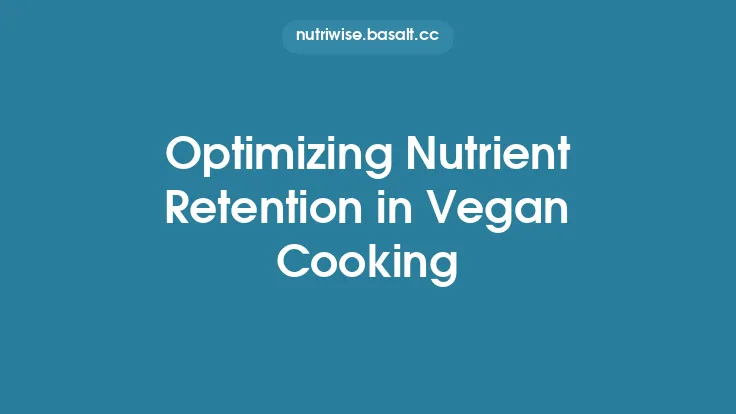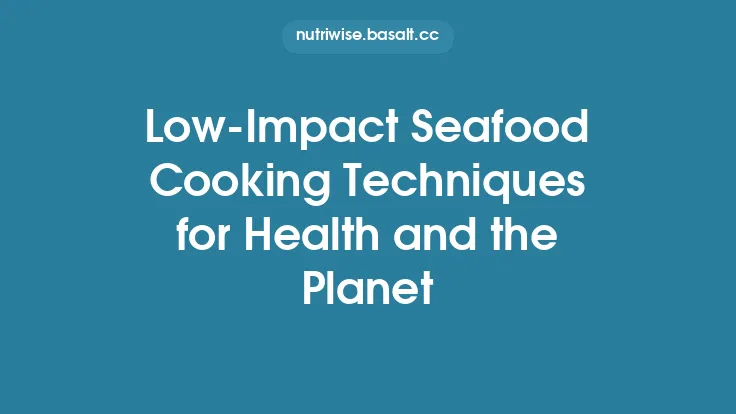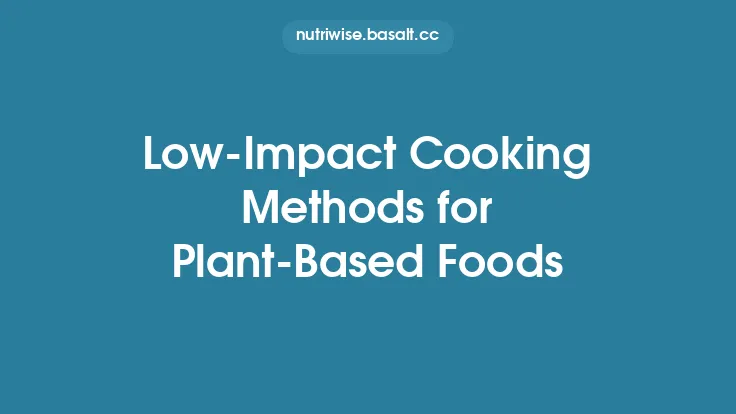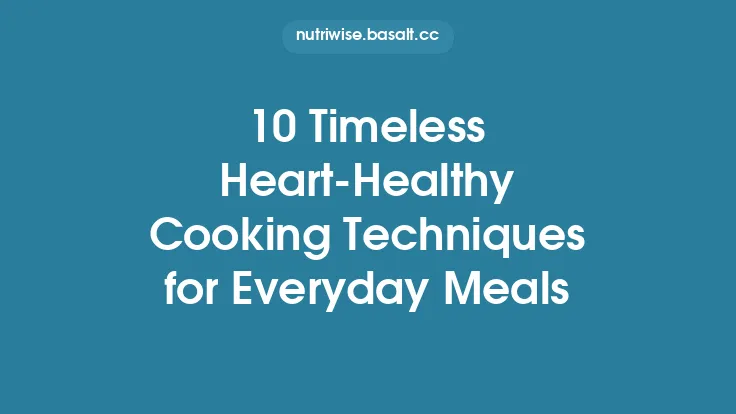Sous‑vide cooking has moved from the realm of high‑end restaurant kitchens into the everyday pantry, offering a method that combines precision, consistency, and, perhaps most importantly for health‑focused cooks, exceptional nutrient preservation. By sealing food in an airtight bag and immersing it in a water bath held at a meticulously controlled temperature, sous‑vide eliminates the guesswork of traditional cooking methods that rely on fluctuating heat and exposure to air. The result is a gentle, uniform heat transfer that minimizes oxidative damage, leaching, and thermal degradation of the very compounds that make fruits, vegetables, meats, and fish so nutritionally valuable.
How Sous‑Vide Works: The Science of Precise Heat Transfer
At its core, sous‑vide is a two‑step process: vacuum sealing and water‑bath immersion. The vacuum seal removes most of the air from the bag, creating an environment with negligible oxygen. This is crucial because oxygen is a primary driver of oxidative reactions that can break down vitamins (especially vitamin C and many B‑vitamins) and polyphenols.
The water bath, typically maintained by an immersion circulator, provides a highly stable temperature—often within ±0.1 °C of the set point. Unlike conventional stovetop or oven cooking, where surface temperatures can far exceed the target (creating hot spots and uneven cooking), the water’s high specific heat capacity ensures that heat is transferred evenly from the outside of the bag to the interior of the food. This uniformity means that the entire piece of food reaches the desired core temperature simultaneously, avoiding the over‑cooking of outer layers that would otherwise accelerate nutrient loss.
Temperature Ranges and Nutrient Stability
| Temperature (°C) | Typical Food Types | Nutrient Impact |
|---|---|---|
| 55‑60 | Tender fish, poultry, eggs | Preserves heat‑sensitive vitamins (C, B‑complex) and delicate omega‑3 fatty acids |
| 60‑70 | Pork, lamb, tougher cuts of beef | Allows collagen conversion to gelatin while retaining B‑vitamins and minerals |
| 70‑85 | Root vegetables, legumes (pre‑cooked) | Softens fibrous tissues without excessive leaching of water‑soluble nutrients |
| 85‑95 | Tough cuts requiring longer breakdown (e.g., brisket) | Extended time compensates for lower temperature, still limiting vitamin loss compared to high‑heat roasting |
Research consistently shows that most vitamins begin to degrade significantly above 80 °C, especially when exposed for prolonged periods. Sous‑vide’s ability to keep core temperatures well below this threshold while still achieving desired textures makes it uniquely suited for nutrient preservation.
Impact on Vitamins and Phytonutrients
Water‑Soluble Vitamins (C, B‑complex):
These vitamins are highly susceptible to heat, light, and oxygen. In sous‑vide, the sealed environment limits oxygen exposure, while the relatively low temperature curtails thermal breakdown. Studies measuring ascorbic acid retention in sous‑vide‑cooked carrots reported up to 95 % retention, compared to 70 % in conventional boiling.
Fat‑Soluble Vitamins (A, D, E, K):
Because sous‑vide does not require large amounts of added fat for heat conduction, the natural lipid matrix of the food remains intact, protecting fat‑soluble vitamins from oxidation. The gentle heat also prevents the formation of free radicals that can degrade these vitamins.
Polyphenols and Carotenoids:
These phytonutrients are prone to oxidative degradation. The vacuum environment dramatically reduces the presence of oxygen, while the absence of direct contact with high‑temperature surfaces prevents the Maillard reaction from consuming these compounds. For example, sous‑vide‑cooked tomatoes retain up to 88 % of lycopene, a figure markedly higher than the 60 % typically observed after oven roasting.
Protein Quality and Amino Acid Retention
Protein denaturation is a natural part of cooking, but excessive heat can cause the loss of essential amino acids, particularly lysine, through Maillard reactions. Sous‑vide’s low‑temperature, long‑time (LTLT) approach minimizes these reactions. The result is a higher proportion of intact, digestible protein. In meat, the conversion of collagen to gelatin at temperatures between 55 °C and 70 °C improves tenderness without sacrificing amino acid integrity, making sous‑vide an excellent method for preserving both texture and nutritional value.
Mineral and Electrolyte Preservation
Minerals such as potassium, magnesium, calcium, and iron are not destroyed by heat, but they can leach into cooking liquids. Because sous‑vide cooking occurs in a sealed bag, any minerals that migrate from the food remain within the same vessel, allowing them to be re‑absorbed during the cooking process. This contrasts with methods that involve draining off cooking water, where mineral loss can be substantial.
Food Safety Considerations
While nutrient preservation is a major advantage, sous‑vide also demands strict attention to food safety:
- Pasteurization Time‑Temperature Curves:
Each food type has a specific combination of temperature and time required to achieve a 7‑log reduction of pathogenic bacteria (e.g., *Salmonella* in poultry). Immersion circulators often provide built‑in calculators or reference tables to guide safe cooking durations.
- Bag Integrity:
A compromised seal can introduce oxygen and contaminants. Using high‑quality, BPA‑free, food‑grade vacuum bags and ensuring a proper vacuum seal are essential.
- Rapid Cooling for Storage:
If the cooked product is not consumed immediately, it should be cooled quickly (e.g., ice bath) and refrigerated or frozen within two hours to prevent bacterial growth.
Adhering to these protocols ensures that the health benefits of nutrient retention are not offset by microbial risks.
Equipment and Technique Optimization
Immersion Circulators:
Modern circulators feature PID (Proportional‑Integral‑Derivative) controllers that maintain temperature stability within ±0.1 °C. For home cooks, a unit with a temperature range of 20 °C–99 °C and a capacity of at least 5 L is sufficient for most batch sizes.
Vacuum Sealers:
A chamber vacuum sealer provides the most reliable air removal, especially for liquids that can be difficult to seal with a handheld pump. However, a high‑quality external‑pump sealer can also achieve satisfactory results for most solid foods.
Bag Materials:
Polyethylene‑nylon (PE‑nylon) bags are preferred for high‑temperature applications (up to 95 °C) because they resist deformation and maintain barrier properties. For lower temperatures, standard polyethylene bags are adequate.
Water Bath Management:
To prevent evaporation and maintain a consistent water level, use a lid or a water‑bath cover. Adding a small amount of oil to the water can reduce surface tension, minimizing heat loss.
Practical Applications in Home Cooking
- Fish Fillets:
Set the circulator to 54 °C, seal the fillet with a slice of lemon and fresh herbs, and cook for 30 minutes. The result is a flaky texture with 92 % retention of omega‑3 fatty acids and minimal loss of vitamin D.
- Chicken Breast:
Cook at 62 °C for 1.5 hours. The gentle heat keeps the meat juicy while preserving B‑vitamins and preventing the formation of heterocyclic amines that can arise from high‑heat grilling.
- Root Vegetables (e.g., sweet potatoes):
Sous‑vide at 85 °C for 1 hour. The interior becomes tender without the nutrient leaching associated with boiling, and the natural sugars caramelize subtly, enhancing flavor without added fats.
- Eggs:
For perfectly set yolks and custard‑like whites, cook at 63 °C for 45 minutes. This method retains the full complement of choline and vitamin B12, which can be diminished by over‑cooking.
Common Misconceptions
- “Sous‑vide cooks food too slowly, destroying nutrients.”
The slow cooking time is offset by the low temperature, which actually protects heat‑sensitive nutrients. Nutrient loss is more closely linked to temperature than to duration.
- “Vacuum sealing removes all nutrients.”
While some volatile compounds may escape if the bag is not properly sealed, the majority of nutrients remain within the sealed environment, and any that migrate into the cooking liquid are retained in the bag.
- “It’s only for meat.”
Sous‑vide is equally effective for vegetables, fruits, eggs, and even dairy products, each benefiting from the method’s gentle heat and sealed environment.
Environmental and Energy Aspects
Sous‑vide’s precise temperature control can be more energy‑efficient than heating a large oven for extended periods. Immersion circulators typically consume 800–1200 W, comparable to a small electric kettle, and the water bath can be insulated with a lid or a thermal blanket to reduce heat loss. Additionally, because the method often eliminates the need for excess oil or butter, it can contribute to lower overall resource consumption in the kitchen.
Looking Ahead: Innovations and Research
Emerging technologies such as sous‑vide‑compatible smart bags with built‑in oxygen scavengers promise even greater nutrient retention by further reducing residual oxygen. Ongoing research into the kinetics of vitamin degradation at sub‑boiling temperatures continues to refine optimal time‑temperature combinations for a wider array of foods. As the scientific community deepens its understanding of how gentle heat interacts with the complex matrix of nutrients, sous‑vide is poised to become a cornerstone of health‑focused culinary practice.
Conclusion
Sous‑vide cooking stands out among culinary techniques for its ability to marry culinary excellence with scientific precision. By maintaining a low, stable temperature within an oxygen‑restricted environment, it safeguards vitamins, minerals, phytonutrients, and high‑quality proteins while delivering consistently tender and flavorful results. For anyone seeking a method that respects the nutritional integrity of food without sacrificing taste or texture, sous‑vide offers a compelling, evidence‑based solution that is both accessible and adaptable to everyday cooking.





